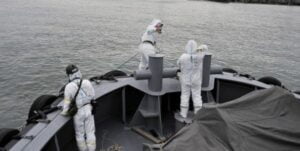Kashiwa hot spot linked to Fukushima nuclear disaster
KASHIWA, Chiba – Officials announced Oct. 21 the city government has discovered a hot spot, Kashiwa hot spot, emitting extremely high radiation of 57.5 microsieverts per hour on a plot of public land in a residential district.Radiation levels in Kashiwa and its

